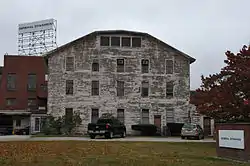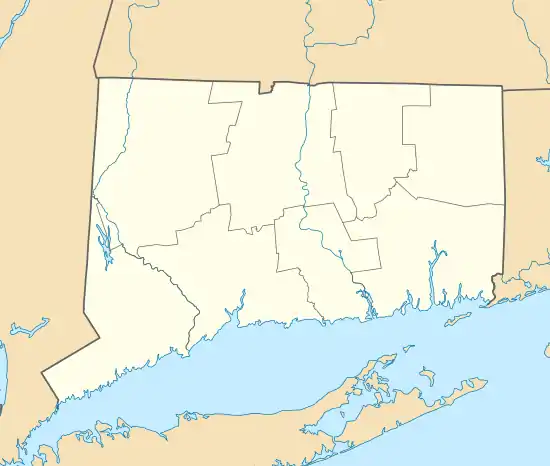Mechanic Street Historic District
The Mechanic Street Historic District encompasses a historic 19th-century mill and mill village in a 14-block area of the Pawcatuck section of Stonington, Connecticut. Extending along the Pawcatuck River and south of West Broad Street (United States Route 1), the area includes a large brick mill complex on the banks of the river, and a neighborhood of well-preserved worker housing on the road grid to its west. The district was listed on the National Register of Historic Places in 1988.[1][2]
Mechanic Street Historic District | |
 | |
  | |
| Location | Roughly bounded by W. Broad St., Pawcatuck River, Cedar St., and Courtland St., Stonington, Connecticut |
|---|---|
| Coordinates | 41°22′23″N 71°49′59″W |
| Area | 147 acres (59 ha) |
| Architect | Pendelton & Hall; Et al. |
| Architectural style | Late 19th and 20th Century Revivals, Greek Revival, Late Victorian |
| NRHP reference No. | 88000653[1] |
| Added to NRHP | June 7, 1988 |
Description and history
The Pawcatuck area of Stonington developed, along with adjacent Westerly, Rhode Island, as a port and shipbuilding center in the early 19th century. Several shipyards lined the western (Stonington) bank of the river, whose worker housing formed the early construction of worker housing on the residential grid to the west. The arrival of the railroad in 1837 led the area to also develop an industrial base, with a foundry established in 1851 and a machine factory in 1857. This plant eventually specialized in the manufacture of printing presses, and was joined later in the 19th century by a textile mill. Worker housing of all types was built nearby, both by the business owners and other parties, to meet the housing demand for the workers employed in these businesses.[2]

The historic district is 147 acres (59 ha) in size, bounded on the north by West Broad Street and the east by the Pawcatuck River. It includes a large waterfront mill complex, with 7 major buildings over a 25-acre (10 ha) area, and a smaller company office building. It extends westward from the mill as far as Courtland Street, the area beyond the railroad tracks consisting mainly of worker housing. The buildings in the residential area are stylistically diverse, including examples of Greek Revival housing from the shipyard period, and tenement-style housing built later in the 19th century.[2]
References
- "National Register Information System". National Register of Historic Places. National Park Service. March 13, 2009.
- Jan Cunningham and John Herzan (December 9, 1987). "National Register of Historic Places Inventory-Nomination: Mechanic Street Historic District". National Park Service. and Accompanying 26 photos, from 1987